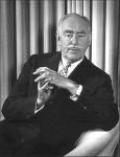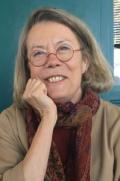They created towns and became the center of Western life, enabling wheat, cattle, and minerals to flow out of the West
Half a century after engines touched pilot to pilot at Promontory, Utah, to complete the first transcontinental railroad, the imprint of the Iron Road was nearly everywhere in the American West. Some enthusiastic real estate promoters and railway officials even claimed that the railroads invented the West—or at least the national image of the West.
In 1800 the United States was an underdeveloped nation of just over 5 million people. It was a society shaped by immigration, but immigrants from one country, Great Britain, made up around half the population.
The story of Chicago in the nineteenth century is the story of the making of America, Donald L. Miller says. A new PBS documentary based on a book he wrote shows why.
50 YEARS AGO serious pro basketball was born. Or at least they tried to be serious.
To Horace Albert (“bones”) McKinney, listening over the phone in his parlor on Fourth Street in Winston-Salem, North Carolina, the words of Arthur Morse sounded just fine. Morse, who was part owner of the Chicago Stags franchise in the brand-new Basketball Association of America (B.A.A.), was saying, “My friend, if Yankee Stadium was built for Babe Ruth, then Chicago Stadium was built for Bones McKinney.”
The Babe and Bones in one mouthful. Not bad, even if Morse was laying it on a bit thick. But in this autumn of 1946 McKinney didn’t mind the blarney. Working as he was in the personnel department of Hanes Hosiery and in off-hours playing for the company basketball team, he found the idea of a pro game appealing. But the prospect of flying to Chicago to wrap the deal—that was another story. If the good Lord had wanted him to fly, Bones liked to say, he’d have provided wings. So McKinney left by train, stopping en route in Washington, D.C.
A BOLD NEW KIND OF COLLEGE COURSE BRINGS the student directly to the past, nonstop, overnight, in squalor and glory, for weeks on end
During a single decade Chicago invented modern organized crime and saw John Dillinger, the most famous of the hit-and-run freelancers, die in front of one of its movie houses. For those who know where to look, quiet streets and sad buildings still tell the story of an incandescent era.
A .45-caliber semiautomatic pistol fires a half-ounce lead cylinder at a speed of 579 miles per hour. If the bullet strikes a brick, it leaves a distinctive mark, a gouge surrounded by radiating cracks.
You’ve probably never heard of them, but these ten people changed your life. Each of them is a big reason why your world today is so different from anyone’s world in 1954
For want of nails, kingdoms are won and lost. We all know that. The shoe slips, the horse stumbles, the army dissolves in retreat. But who designed the nails? Who hammered the nails? Who invented the nail-making machinery?
The most powerful columnist who ever lived single-handedly made our current culture of celebrity— and then was destroyed by the tools he had used to build it
“WHY WALTER WINCHELL?” I have been asked repeatedly during the years I have been working on a biography of him. Why someone so passé or someone so beneath contempt as also to be beneath biography?
This isn’t the first time a Virginia governor has found himself embroiled in controversy about the commercialization of a Civil War site
WHEN THE CIVIL War ended, a second fierce and divisive conflict began, fought on the same battlefields but over a different issue: not political secession but the commercial development of the battlefields themselves.
WHAT HAPPENED when a historian largely indifferent to the subject set out to write the script for Ken Burns’s monumental new documentary
I’VE NEVER LIKED BASEBALL MUCH, IN part because my father has always loved it so.
Once seen as a vice and now as a public panacea, the national passion that got Thomas Jefferson in trouble has been expanding for two centuries
“I’m dad-gum disgusted at trying to police every half-square and every half-house,” Sen. Huey Long told a radio audience in Louisiana in May 1935. “You can’t close gambling nowhere where the people want to gamble.”
Americans invented the grand hotel in the 183Os and during the next century brought it to a zenith of democratic luxury that makes a visit to the surviving examples the most agreeable of historic pilgrimages
At the turn of the eighteenth century, a story went around Connecticut about a pious old woman who was berating her nephew for being such a rake. And an aging rake, at that. “But we’re not so very different,” he insisted.
First heard just a century ago at the Chicago fair, Frederick Jackson Turner’s epochal essay on the Western frontier expressed a conflict in the American psyche that tears at us still
This country’s long, acrimonious observance of the Columbian quincentenary is finally over, but it won’t be soon forgotten.
THE 1893 WORLD’S COLUMBIAN EXPOSITION WAS SO WONDERFUL THAT EVERYBODY HOPED IT WAS A PROPHECY OF WHAT THE TWENTIETH CENTURY HELD IN STORE. BUT IN FACT, THE CITY THAT MOUNTED IT WAS.
“The world’s greatest achievement of the departing century was pulled off in Chicago,” said George Ade, one of the city’s first important writers.
A Romanesque mansion in Chicago was built to forbid outsiders while providing a warm welcome to guests within
Every spring thirty million Americans watch the Indianapolis 500. It’s the nation’s premier racing event and the pinnacle of a glamorous, murderous epic that stretches back nearly a century.
May is a month of traditions: of flowers and commencements, of the Kentucky Derby for 117 years and Indianapolis five-hundred-mile races for 81. For an automobile race, Indy is ancient.
A clipping selected at random from a generous stack tells me that the would-be Democratic candidate Tom Harkin is pitching a “populist, sharply partisan message.” I get the impression that the two adjectives are interchangeable.
Seventy-five years ago this month, a not especially good band cut a record that transformed our culture
About 325,000 jazz performances have been recorded for commercial release in the twentieth century, according to the Institute for Jazz Studies, at Rutgers University. Plus thousands more have been taken from radio and concert events.
At the dawn of this century a new form of residential architecture rose from the American heartland, ruled by the total integration of space, site, and structure
After dinner Frank Lloyd Wright would sometimes raise a wineglass, watch the yellow candlelight refracted through the red liquid and crystal, and, quoting the Chinese philosopher Lao-tze, remark that the reality of the vessel lay in the void within, “the plac
Robert Johnson died in obscurity in 1938; since then he has gradually gained recognition as a genius of American music. Only recently have the facts of his short, tragic life become known.
Who was Robert Johnson? For so many years that question haunted all of us who loved the blues. Certainly we knew about Robert Johnson’s music.
What seemed to be just another tempest in the teapot of academia has escalated into a matter of national values and politics. Who would have believed that the choice of which books Stanford University students must read would create so much tumult? And that the controversy goes back so far?
Allan Bloom’s The Closing of the American Mind must surely be the most unexpected happening of American intellectual life in recent years. It is an erudite, closely argued book of philosophy and cultural criticism.
Every presidential election is exciting when it happens. Then the passing of time usually makes the outcome seem less than crucial. But after more than a century and a quarter, the election of 1860 retains its terrible urgency.
In the crowded months between the beginning of the 1860 presidential campaign and the attack on Fort Sumter, it is easy now to see the emergence of Abraham Lincoln as something preordained, as though the issues had manufactured a figure commensurate with their importance.
While New York families were spending fortunes inherited from fathers and grandfathers, the Chicago rich had to start from scratch, both making and lavishly spending money within one generation
Visitors to Chicago have tended either to love the city or to despise it, but its bursting vitality has awed everyone. Perhaps Mark Twain expressed it best.
It was born in America, it came of age in America, and in an era when foreign competition threatens so many of our industries, it still sweetens our balance of trade
The candy bar as we know it was born in America. So too, many centuries earlier, was chocolate itself. Mexican natives cultivated the cocoa bean for more than twenty-five hundred years before Hernán Cortés took it to Spain with him in 1528.
During the 1920s the city spurred local rail traffic with an unparalleled run of superb and stylish posters
Surprisingly little is known about the posters shown on these pages. Springing up practically overnight in the mid-1920s, they bloomed for a short while, four or five years at most, and then their season, was over.
was the first magazine in America to change its cover for every issue. And these covers may still be the best graphic art magazine has ever produced.
Jack Hughes was an outstanding passer of phony bills.
An Interview With the King of Swing
Benny Goodman strolled down New York’s Second Avenue one recent morning, covering the nine blocks between his apartment and a health club, where he swims each day, in about ten minutes.
A REMARKABLE SOCIOLOGICAL EXPERIMENT SHOWED YOU COULD DO IT—IF YOU COULD STAND IT
In 1893 Chicago played host to a World’s Fair that rivaled the Paris Exposition of 1889 for splendor and exceeded all previous fairs in magnitude.





